NCERT Exemplar Solutions for Class 12 Biology Chapter 12 Biotechnology and Its Applications, provided by BYJU’S, is the best study material on which you can rely on to prepare for your CBSE Class 12 board examination as well as entrance examinations like NEET and AIPMT.
Practising the NCERT Exemplar Solutions for Class 12 Biology Chapter 12 will help you excel in the board examination by making you understand the concepts thoroughly and also get familiar with the different kinds of questions that can be asked in the examination. Students can download these Solutions in PDF from the link below.
Download the PDF of NCERT Exemplar Solutions for Class 12 Biology Chapter 12 Biotechnology and Its Applications
Access NCERT Exemplar Solutions for NCERT Class 12 Biology Chapter 12 Biotechnology and Its Applications
MULTIPLE-CHOICE QUESTIONS
1. Bt cotton is not:
a. A GM plant
b. Insect-resistant
c. A bacterial gene expressing system
d. Resistant to all pesticides
Solution:
Option (d) is the answer.
2. C-peptide of human insulin is:
a. A part of mature insulin molecule
b. Responsible for the formation of disulphide bridges
c. Removed during maturation of pro-insulin to insulin
d. Responsible for its biological activity
Solution:
Option (c) is the answer.
3. GEAC stands for:
a. Genome Engineering Action Committee
b. Ground Environment Action Committee
c. Genetic Engineering Approval Committee
d. Genetic and Environment Approval Committee
Solution:
Option (c) is the answer.
4. α -1 antitrypsin is:
a. An antacid
b. An enzyme
c. Used to treat arthritis
d. Used to treat emphysema
Solution:
Option (d) is the answer.
5. A probe which is a molecule used to locate homologous sequences in a mixture of DNA or RNA molecules, could be:
a. An ssRNA
b. An ssDNA
c. Either RNA or DNA
d. Can be ssDNA but not ssRNA
Solution:
Option (c) is the answer.
6. Choose the correct option regarding Retrovirus:
a. An RNA virus that synthesises DNA during infection
b. A DNA virus that synthesises RNA during infection
c. An ssDNA virus
d. A dsRNA virus
Solution:
Option (a) is the answer.
7. The site of production of ADA in the body is:
a. Erythrocytes
b. Lymphocytes
c. Blood plasma
d. Osteocytes
Solution:
Option (b) is the answer.
8. A protoxin is:
a. A primitive toxin
b. A denatured toxin
c. The toxin produced by protozoa
d. Inactive toxin
Solution:
Option (d) is the answer.
9. Pathophysiology is the:
a. Study of physiology of pathogen
b. Study of the normal physiology of host
c. Study of altered physiology of host
d. None of the above
Solution:
Option (c) is the answer.
10. The trigger for activation of the toxin of Bacillus thuringiensis is:
a. Acidic pH of stomach
b. High-temperature
c. Alkaline pH of gut
d. Mechanical action in the insect gut
Solution:
Option (c) is the answer.
11. Golden rice is:
a. A variety of rice grown along the yellow river in China
b. Long stored rice having yellow colour tint
c. Transgenic rice having the gene for β – carotene
d. The wild variety of rice with yellow-coloured grains
Solution:
Option (c) is the answer.
12. In RNAi, genes are silenced using:
a. ss DNA
b. ds DNA
c. ds RNA
d. ss RNA
Solution:
Option (c) is the answer.
13. The first clinical gene therapy was done for the treatment of:
a. AIDS
b. Cancer
c. Cystic fibrosis
d. SCID (Severe Combined Immuno Deficiency resulting from
deficiency of ADA)
Solution:
Option (d) is the answer.
14. ADA is an enzyme which is deficient in a genetic disorder SCID. What is
the full form of ADA?
a. Adenosine deoxyaminase
b. Adenosine deaminase
c. Aspartate deaminase
d. Arginine deaminase
Solution:
Option (b) is the answer.
15. Silencing of a gene could be achieved through the use of:
a. RNAi only
b. antisense RNA only
c. both RNAi and antisense RNA
d. none of the above
Solution:
Option (c) is the answer.
VERY SHORT ANSWER TYPE QUESTIONS
1. In view of the current food crisis, it is said that we need another green revolution. Highlight the major limitations of the earlier green revolution.
Solution:
1. It wasn’t helpful for poor farmers as the HYV seeds and pesticides were costly. It led to farmer debts.
2. The green revolution was only limited to food grain crops, and the major focus was on wheat and rice only.
3. The high-yielding variety (HYV) required additional water and fertilizers to give good crop yields.
2. Expand GMO. How is it different from a hybrid?
Solution:
GMO stands for genetically modified organism. Hybrids are produced by crossbreeding or cross-pollinating two different animal or plant species, whereas the production of GMO involves the insertion of a gene into a new organism to express a specific trait or character.
3. Differentiate between diagnostics and therapeutics. Give one example for each category.
Solution:
Diagnostics involves the detection of diseases. It can be of various types. For example, ELISA (i.e., Enzyme-Linked Immunosorbent Assay) is a diagnostic technique used for the detection of HIV, Hepatitis B, and Hepatitis C. Therapeutics help in the treatment of a specific type of disease. Ampicillin is a therapeutic agent who is an antibiotic that helps in the treatment of bacterial infections in humans
4. Give the full form of ELISA. Which disease can be detected using it? Discuss the principle underlying the test.
Solution:
The full form of ELISA is an Enzyme-Linked Immunosorbent Assay which is a diagnostic method which is used for the detection of HIV, Hepatitis B and Hepatitis C
The principle of ELISA is to assay a reaction which uses an enzyme which can be easily assayed with an antigen or specific antibodies.
5. Can a disease be detected before its symptoms appear? Explain the principle involved.
Solution:
Yes, some of the diseases can be detected before their symptoms, like using PCR (Polymerase chain reaction) which is used to amplify nucleic acid to obtain an amplified gene product which can show diseases before their symptoms.
6. Write a short note on Biopiracy highlighting the exploitation of developing countries by developed countries.
Solution:
The term biopiracy refers to the unethical and unauthorized use of biological resources by multinational companies and other organizations without permission from concerned authorities and individuals.
7. Many proteins are secreted in their inactive form. This is also true of many toxic proteins produced by microorganisms. Explain how the mechanism is useful for the organism producing the toxin.
Solution:
The mechanism is useful for micro-organisms because they become active only by certain metabolic and biochemical changes like pH changes or temperature changes. Hence these toxins resist the protein and by the action of the host, the microorganisms do not get killed.
8. While creating genetically modified organisms, genetic barriers are not respected. How can this be dangerous in the long run?
Solution:
It could lead to the production of unwanted organisms, which can affect and disrupt the general food chain of other organisms.
9. Why has the Indian Parliament cleared the second amendment of the country’s patent bill?
Solution:
It prevents the overexploitation of bio-resources and the use of ancient Indian knowledge and techniques by other countries.
10. Give any two reasons why the patent on Basmati should not have gone to an American Company.
Solution:
Basmati rice variety belongs to India and has been cultivated since time immemorial.
The patent crop claimed by an American company was derived by crossing the Indian rice variety.
11. How was Insulin obtained before the advent of rDNA technology? What were the problems encountered?
Solution:
Insulin is obtained from the pancreas of slaughtered animals. Due to slight changes in the polypeptide chain, it developed allergic reactions in humans
12. Concerning understanding diseases, discuss the importance of transgenic animal models.
Solution:
Transgenic animals are used as a model organism for the production of desired products. They are used to study diseases like cancer and Alzheimer’s and their treatment. In future, it can be used to grow human organs for transplant purposes.
13. Name the first transgenic cow. Which gene was introduced in this cow?
Solution:
Rosie was the first transgenic cow. Gene coding for the production of α-lactoalbumin was introduced into the cow.
14. PCR is a useful tool for early diagnosis of an infectious disease. Elaborate.
Solution:
PCR involves the amplification of DNA strands. Hence, the infectious organism can be detected at an early stage of infection due to the production of its multiple copies, which can be detected easily.
15. What is GEAC, and what are its objectives?
Solution:
1. The main objective of GEAC is to decide the validity of genetic recombination.
2. To test the safety of the introduction of genetically modified organisms in public services.
16. For which variety of Indian rice, the patent was filed by a USA Company?
Solution:
The patent was filed for a rice variety obtained by crossing Basmati rice and semi-dwarf variety of rice.
17. Discuss the advantages of GMO.
Solution:
1. GM plants have increased nutritional value and higher yield.
2. Cost-effective
3. It increases resistance toward pests and diseases e.g. Bt cotton.
SHORT ANSWER TYPE QUESTIONS
1. Gene expression can be controlled with the help of RNA. Explain the method with an example.
Solution:
Gene expression can be controlled with the help of RNA by a method known as RNA interference (i.e., RNAi) in which a gene is “knocked out’’ and the cellular mechanism is degraded. The specific mRNA gene is silenced by binding a complementary double-stranded RNA (i.e., dsRNA) to the mRNA, which inhibits the translation process. For example, the Agrobacterium vector forms a complementary dsRNA with the nematode genes and inhibits translation, and the nematode infection gene expression doesn’t occur.
2. Ignoring our traditional knowledge, can we prove costly in the area of biological patenting? Justify.
Solution:
India is one of the developed countries and very rich in biodiversity when compared to other developed countries. If countries like India don’t have the proper biological patenting rules for its traditional knowledge, then the developed countries would keep on exploiting its resources without giving any due credit or compensation.
3. Highlight any four areas where genetic modification of plants has been useful.
Solution:
1. Genetically modified plants are more resistant towards abiotic stresses like climate, temperature and pH changes.
2. Chemical pesticides are resisted, which enhances crop production.
3. Genetically modified plants are used to grow crops with higher nutritional values like starch, proteins, and vitamins.
4. What is a recombinant DNA vaccine? Give two examples.
Solution:
Recombinant DNA vaccines are vaccines which are manufactured by Recombinant DNA technology. It involves the construction of a plasmid using a copy of DNA from a pathogen with an empty plasmid. Example: Hepatitis B and Japanese encephalitis vaccine.
5. Why is it that the line of treatment for a genetic disease is different from infectious diseases?
Solution:
The line of treatment for a genetic disease is different from infectious diseases as the genetic disease requires a change or alteration in the gene instead of any part or organ. Generally, the gene therapy method is required for the treatment of genetic diseases, which is carried out at the embryo stage. These are caused by pathogens.
6. Discuss briefly how a probe is used in molecular diagnostics.
Solution:
A probe is used in molecular diagnostics for labelling a gene or small fragment of genome segment. For labelling DNA sequence, RNA or DNA fragment is used, and also for genome mapping and sequencing.
A probe is generally radio-labelled or fluorescent-labelled and detected by various methods.
7. Who was the first patient who was given gene therapy? Why was the given treatment recurrent in nature?
Solution:
The first patient who was given gene therapy was a four-year-old with adenosine deaminase (ADA) deficiency. The treatment is recurrent because these ADA cDNAs are not immortal. Thus it is required o be repeated for new cells and cure the adenosine deaminase (ADA) deficiency.
8. Taking examples under each category, discuss upstream and downstream processing.
Solution:
Upstream processing is the method and technique which are involved in the isolation of DNA. An example of upstream processing is used in the production of Insulin using rDNA technology. Downstream processing is the separation, purification, quality control and clinical trials of a product before commercially selling it. An example of downstream processing is the production of Insulin using rDNA technology.
9. Define Antigen and Antibody. Name any two diagnostic kits based on them.
Solution:
Antigen- Any foreign body which can stimulate antibody formation by the immune system
Antibody- it is the glycoprotein produced by the immune system for defence purposes.
Two diagnostic tests based upon antigen-antibody relationship are-
a. ELISA for AIDS
b. Pregnancy test
10. ELISA technique is based on the principles of antigen-antibody interaction. Can this technique be used in the molecular diagnosis of a genetic disorder, such as phenylketonuria?
Solution:
Yes, ELISA can be used to detect the presence of phenylketonuria. The patient in which enzyme-antibody complex enzyme is absent will give a negative test and would prove the absence of the enzyme.
11. How is a mature, functional insulin hormone different from its prohormone form?
Solution:
Proinsulin contains 3 chains of polypeptides i.e. A, B & chain C. Chain A have 21 amino acids, B contains 30 amino acids & chain c consists of 33 amino acids. When C-peptide is removed and cut, A & B peptide chains are joined by disulfide bonds and mature, functional insulin is formed.
12. Gene therapy is an attempt to correct a genetic defect by providing a normal gene to the individual. By this, the normal function can be restored. An alternate method would be to provide the gene product (protein/enzyme) known as enzyme replacement therapy, which would also restore the function. Which is your opinion is a better option? Give a reason for your answer.
Solution:
Gene therapy is considered to be a better option due to the potential to completely cure the genetic defect. If gene replacement is done during embryonic condition, it could be a permanent cure
13. Transgenic animals are the animals in which a foreign gene is expressed. Such animals can be used to study the fundamental biological process, a phenomenon, as well as for producing products useful for mankind. Give one example for each type.
Solution:
In Canada, the gene for spider web has been isolated from spiders & was inserted into a goat. The goat now produces spider webs along with milk. Due to their great tensile strength & lightweight, these spider web fibres are used for the development of military uniforms & tennis rackets.
14. When a foreign DNA is introduced into an organism, how is it maintained in the host and how is it transferred to the progeny of the organism?
Solution:
DNA ligase joins the foreign DNA sequence with the vector plasmid and whenever the cell replicates, DNA sequence also gets replicated. The form on generation to other generation along the vector’s DNA the foreign DNA is also passed on.
15. Bt cotton is resistant to pests, such as lepidopteron, dipterans and coleopterans. Is Bt cotton also resistant to other pests as well?
Solution:
Bt toxin is a species-specific, narrow-spectrum biopesticide. It can only protect the plant only from insects belonging to lepidopteron, dipterans and coleopterans.
LONG ANSWER TYPE QUESTIONS
1. A patient is suffering from ADA deficiency. Can he be cured? How?
Solution:
ADA (i.e., adenosine deaminase) deficiency is a genetic disorder caused by the deletion of a gene for adenosine deaminase synthesis which leads to the deficiency of the ADA enzyme in the body, which causes damage to the immune system. It can be cured by bone marrow transplantation or enzyme replacement therapy. These do not cure the deficiency completely. Another approach is like growing lymphocytes outside the body of the patient in cell culture and using a functional ADA complementary DNA (i.e., cDNA) in those lymphocytes. If this procedure is done at an embryonic stage, then it can be cured permanently.
2. Define transgenic animals. Explain in detail any four areas where they can be utilized.
Solution:
Transgenic animals are animals which are genetically modified for various purposes. By using the recombinant DNA technology, a foreign gene named ‘Transgene’ is inserted into the target organism to bring modifications in their gene expression.
1. Biological studies:
2. Increases the yield product
3. Testing and clinical trials
4. Diseases study and chemical safety testing
3. You have identified a useful gene in bacteria. Make a flow chart of the steps that you would follow to transfer this gene to a plant.
Solution:
Step 1 Isolation of useful gene by using restriction endonuclease enzymes
↓
Step 2: Transferring the isolated gene to a suitable vector to create a recombinant DNA molecule
↓
Step 3: Transfering the recombinant DNA molecule into the target cell
↓
Step 4: Screening of cells for obtaining the transformed cells and discarding the untransformed cell.
↓
Step 5: Selection of the required transformed cell
↓
Step 6: Regeneration of the plants from the transformed cells to get a transgenic plant.
4. Highlight five areas where biotechnology has influenced our lives.
Solution:
The five areas where biotechnology has influenced our lives are:
1. Therapeutics and Diagnostic tool: There are methods which treat adenosine deaminase deficiency, and rDNA technology is used for the production of Insulin and Human Growth Hormone (HGH). PCR (i.e., Polymerase Chain Reaction) is widely used as a diagnostic tool for disease detection and methods like gene therapy are used.
2. Genetically modified plants and animals: Transgenic animals are one of the kinds of modified organisms which is used to get more products like milk from cows, wool from sheep etc.
3. Forensic and paternity tests: Biotechnological methods like DNA fingerprinting have helped in solving crime cases and the determination of genetic parents.
4. Wastewater treatment: Micro-organisms are added to the wastewater, which is digested by the bacteria, and it helps in the degradation of organic waste.
5. Energy production: Biotechnology is used for the production of energy through micro-organisms and producing biofuel.
5. What are the various advantages of using genetically modified plants to increase the overall yield of the crop?
Solution:
1. Genetically modified plants are more resistant towards abiotic stresses like climate, temperature and pH changes. Thus, the plants can grow normally in unfavourable conditions.
2. Genetically modified plants can give more yields of products.
3. Genetically modified plants are more resistant towards pests and insects
4. Genetically modified plants are used for growing crops with higher nutritional values in starch, proteins, vitamins, etc.
5. Genetically modified plants have products i.e., fruits or vegetables, with a much longer shelf life.
6. Explain with the help of one example of how genetically modified plants can:
(a) Reduce the usage of chemical pesticides
(b) Enhance the nutritional value of food crops
Solution:
(a) A nematode, Meloidogyne incognita, is known to cause root rot in the tobacco plant. Initially, nematocides were used to deal with this nematode. The RNA interference (RNAi) method was developed by scientists to kill the nematode by modifying the tobacco crop. Scientists introduced a host-specific double standard DNA using Agrobacterium tumefaciens.
(b) Golden rice is the transgenic variety of basmati rice which gives high yield and is rich in vitamin A, a β-carotene gene from the daffodil plant that was introduced into the rice plant to nutritionally enrich with vitamin A
7. List the disadvantages of insulin obtained from the pancreas of slaughtered cows and pigs:
Solution:
1. The insulin obtained from slaughtered animals was slightly different from humulin and caused allergic reactions in humans
2. Slaughtering animals for insulin is against ethics.
3. Cost of bovine insulin was very high.
8. List the advantages of recombinant insulin.
Solution:
1. Recombinant insulin had no allergic reactions, while bovine-caused allergy.
2. This stopped slaughtered of a large number of animals
9. What is meant by the term bio-pesticide? Name and explain the mode of action of a popular bio-pesticide.
Solution:
Bio-pesticides are biologically present substances which are used to control pests.
These are narrow-spectrum & species-specific. e.g. – Bt toxin, which is obtained from Bacillus thuringiensis, is used against insects. Insects, when ingesting Bt toxin, due to the presence of its alkaline nature, Bt toxin gets activated and binds to the gut wall, and creates pores hence the insects die.
10. Name the five key tools for accomplishing the tasks of recombinant DNA technology. Also, mention the functions of each tool.
Solution:
a) Restriction endonuclease – It cuts the DNA sequence at specific positions.
b) Vector – It is the most important tool for the rDNA technology vector contains a site for the insertion of the gene of interest called the origin of replication.
c) DNA ligase – It facilitates the joining of desired DNA with vector DNA
d) Polymerase – The enzyme makes multiple copies of rDNA.
e) Host cell – The cell which takes up rDNA & changes itself to transformant.
When Biology is used to develop solutions and technologies to improve the lives of human beings, this technology is called Biotechnology. The field of Biotechnology has many different uses, particularly in the modern day. Its applications are quite varied and have a close link with various fields such as energy production, GMOs, food processing and waste management.
Important Topics of Class 12 Biology Chapter 12 Biotechnology and Its Application
- Biotechnological Applications in Agriculture – Genetically modified organisms, BT Cotton, pest-resistant plants,
- Biotechnological Applications in Medicine – Genetically engineered insulin, gene therapy
- Transgenic Animals
- Ethical Issues.
Why Opt for BYJU’S?
For students who want to pursue a career in Biology-related fields, Chapter 12, Biotechnology and Its Applications, is a fundamental topic for grasping advanced concepts in future. To help you get thorough with the concepts covered in this chapter, BYJU’S provides videos, animations, infographics, notes, exercises and assignments that will help you grasp the concepts thoroughly and memorise them for a long period of time.
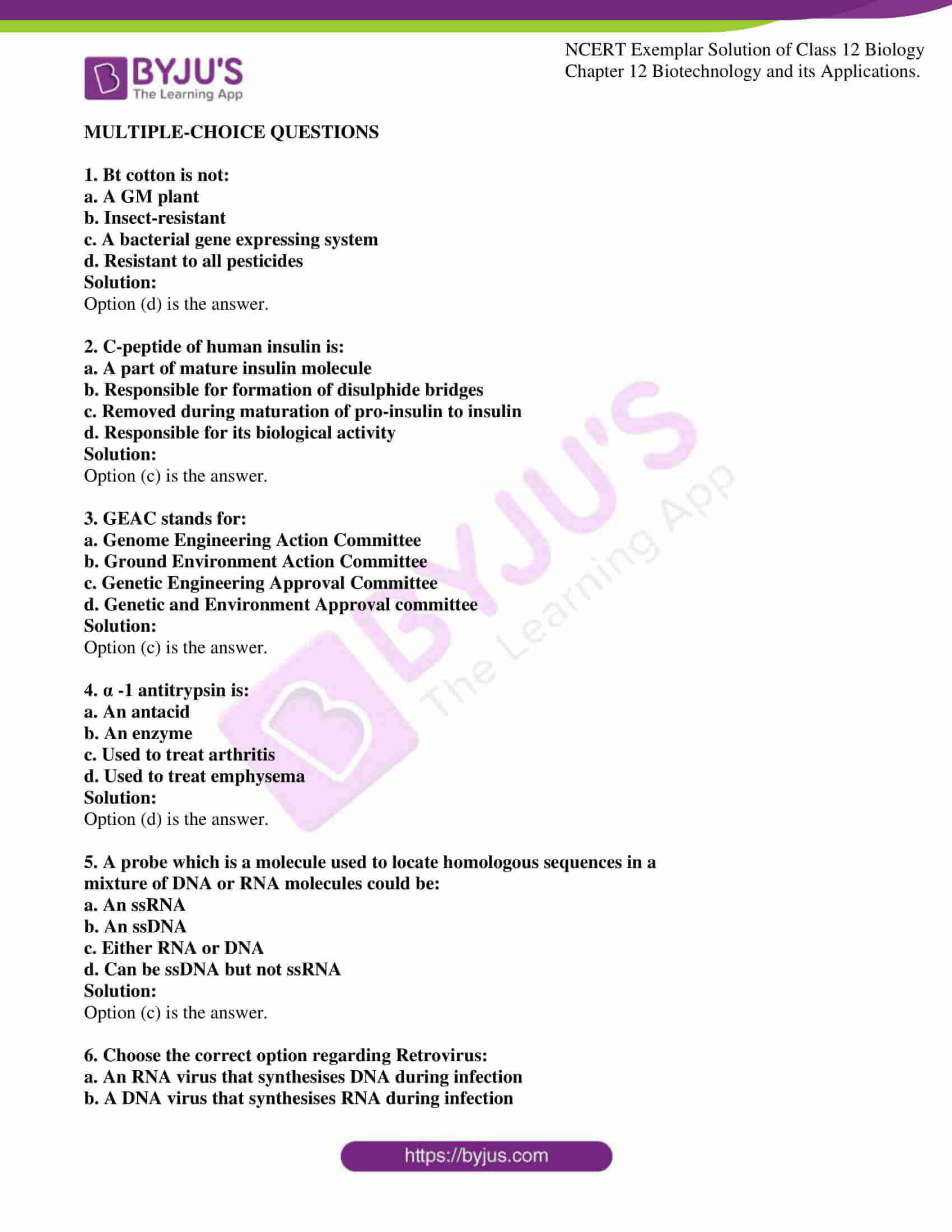
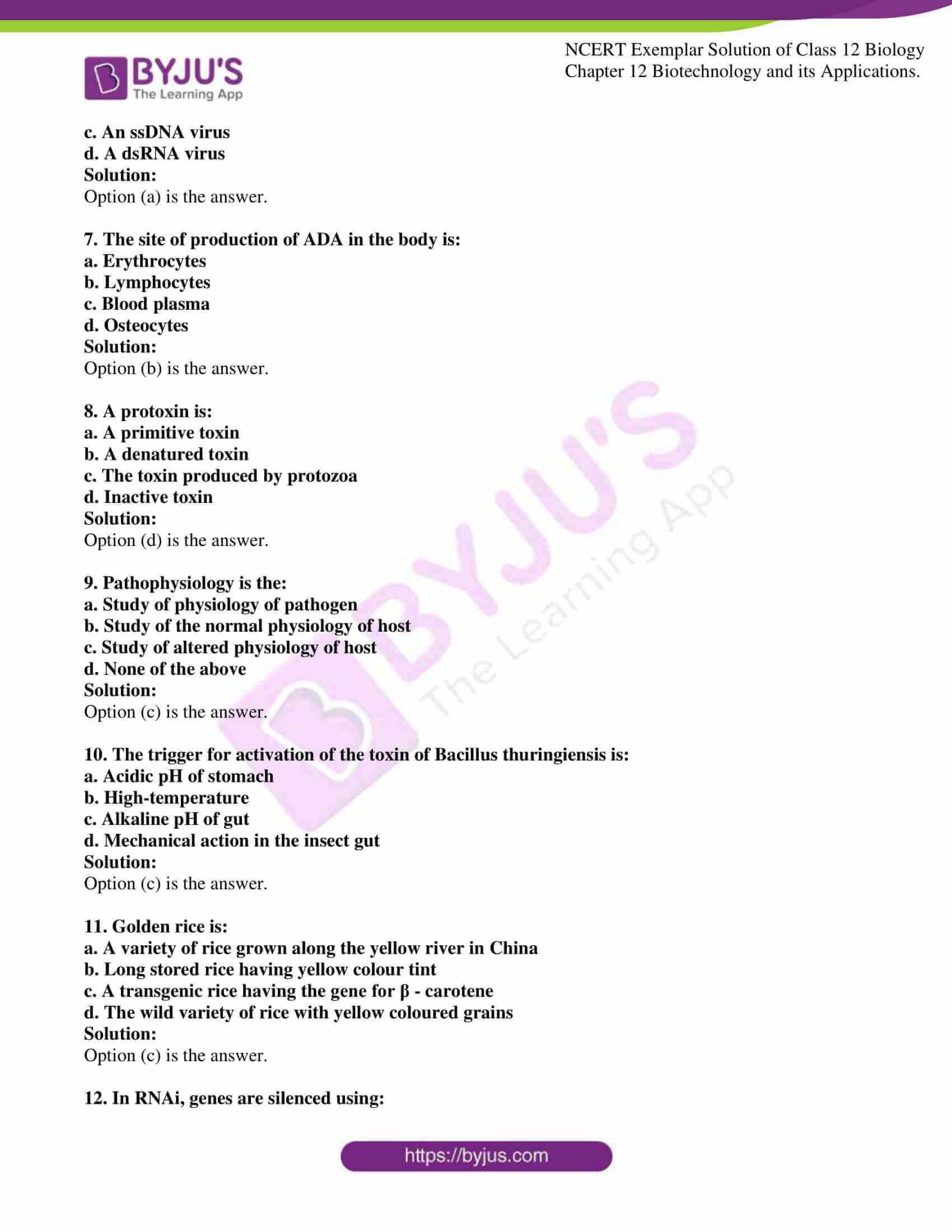
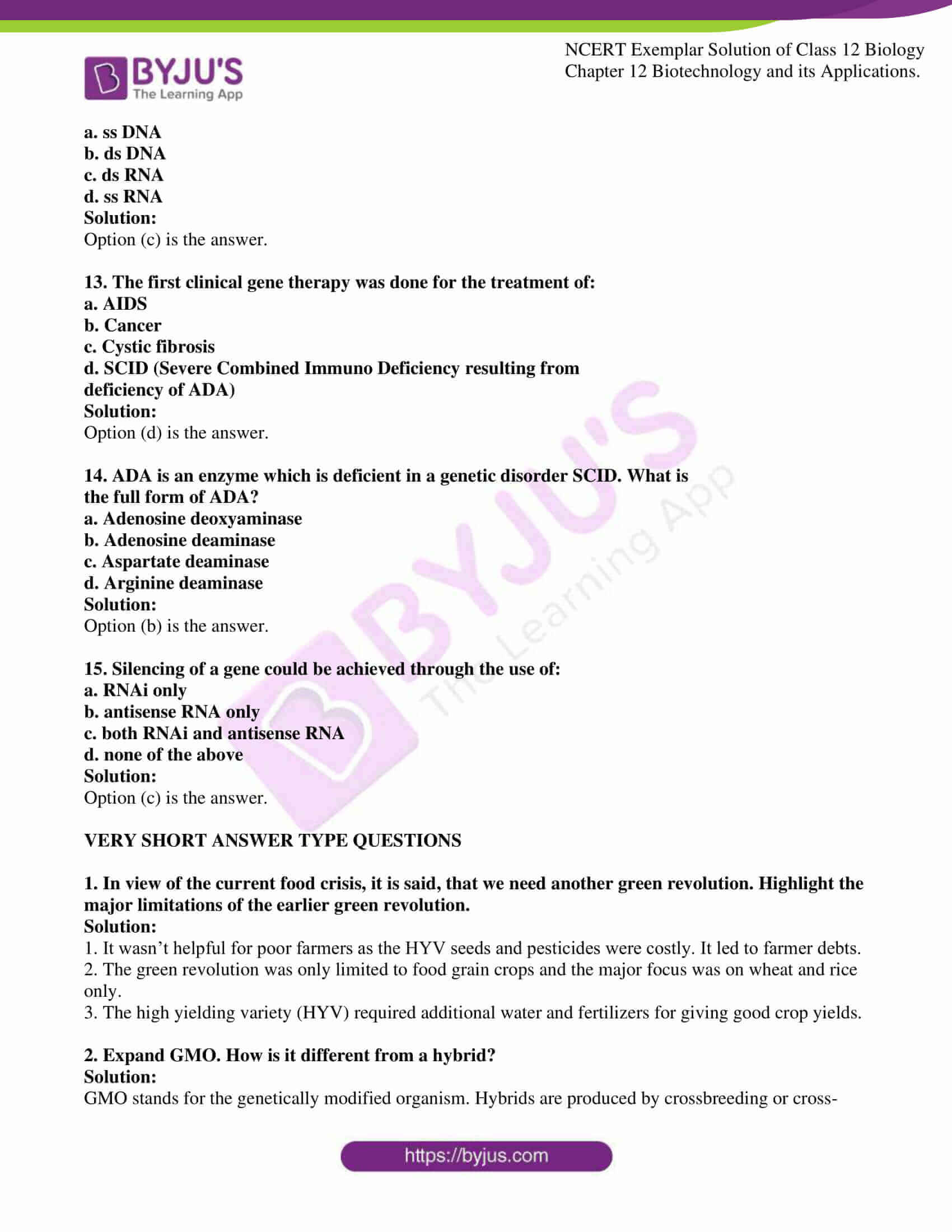
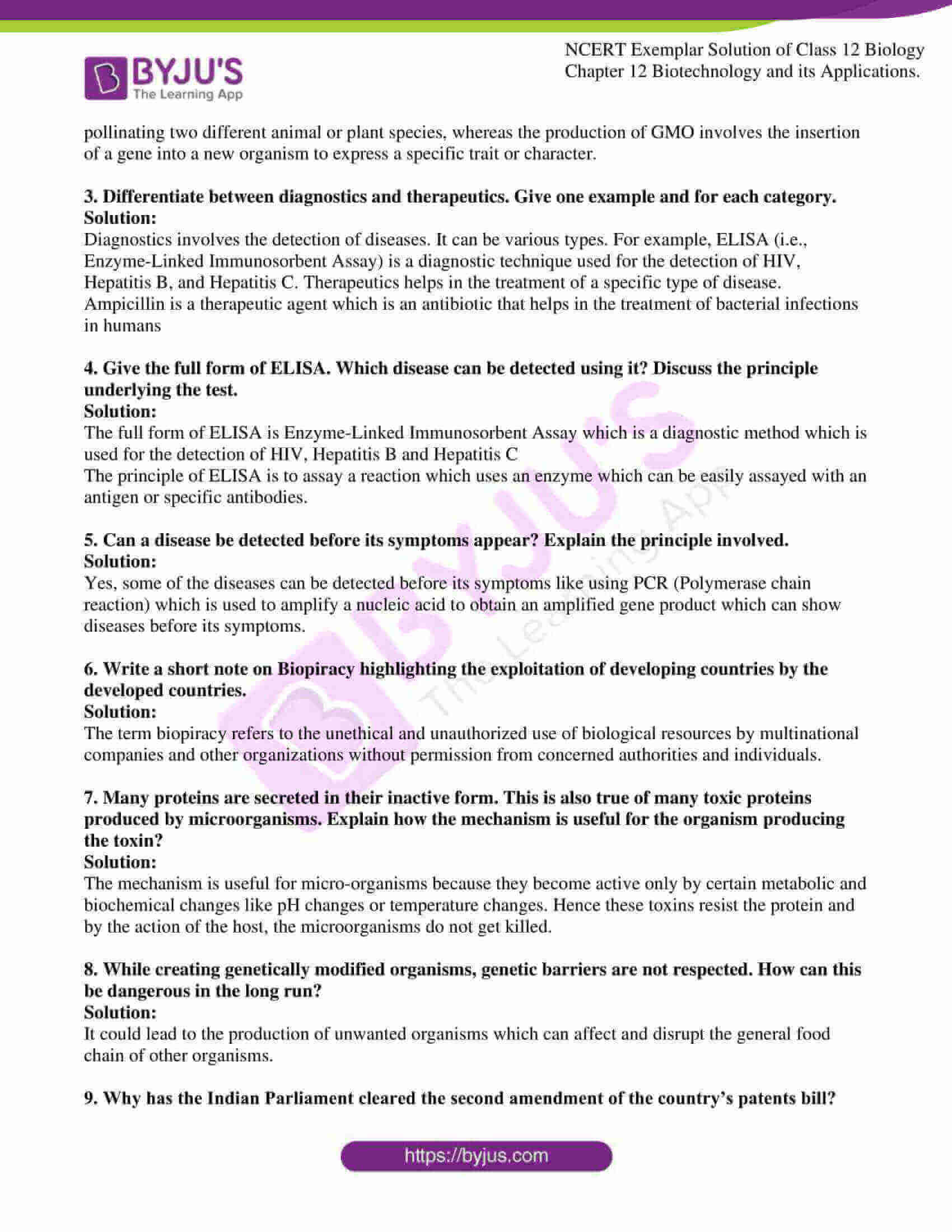
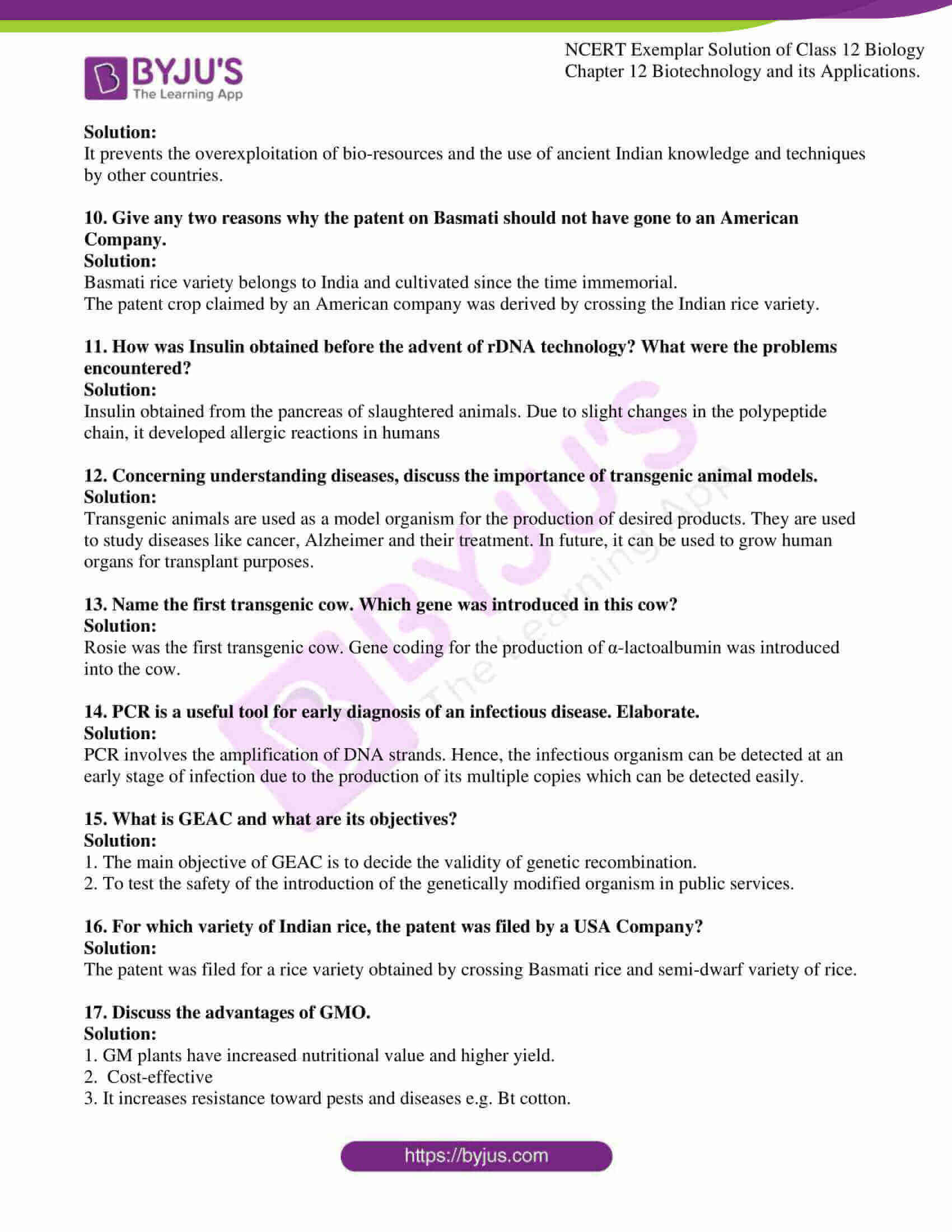
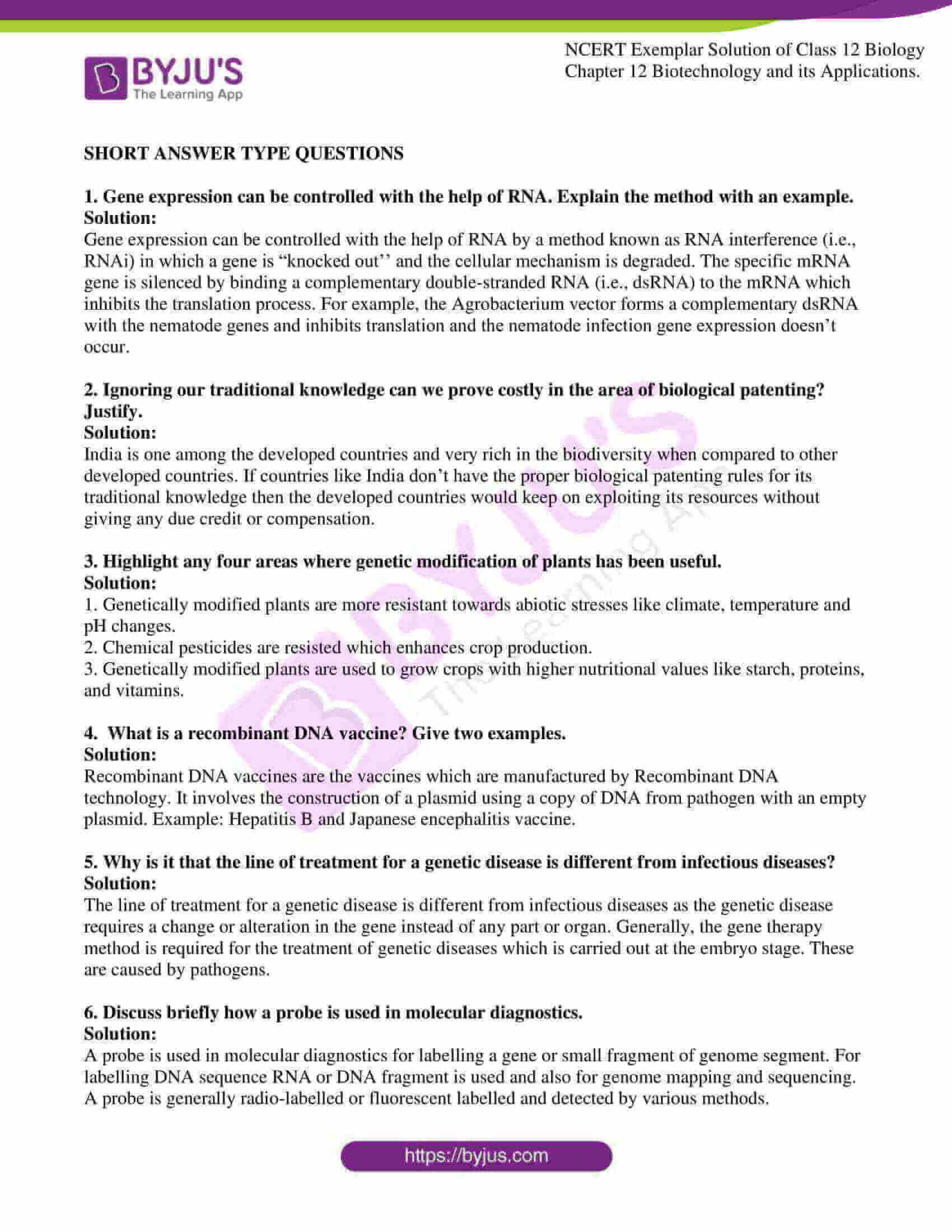
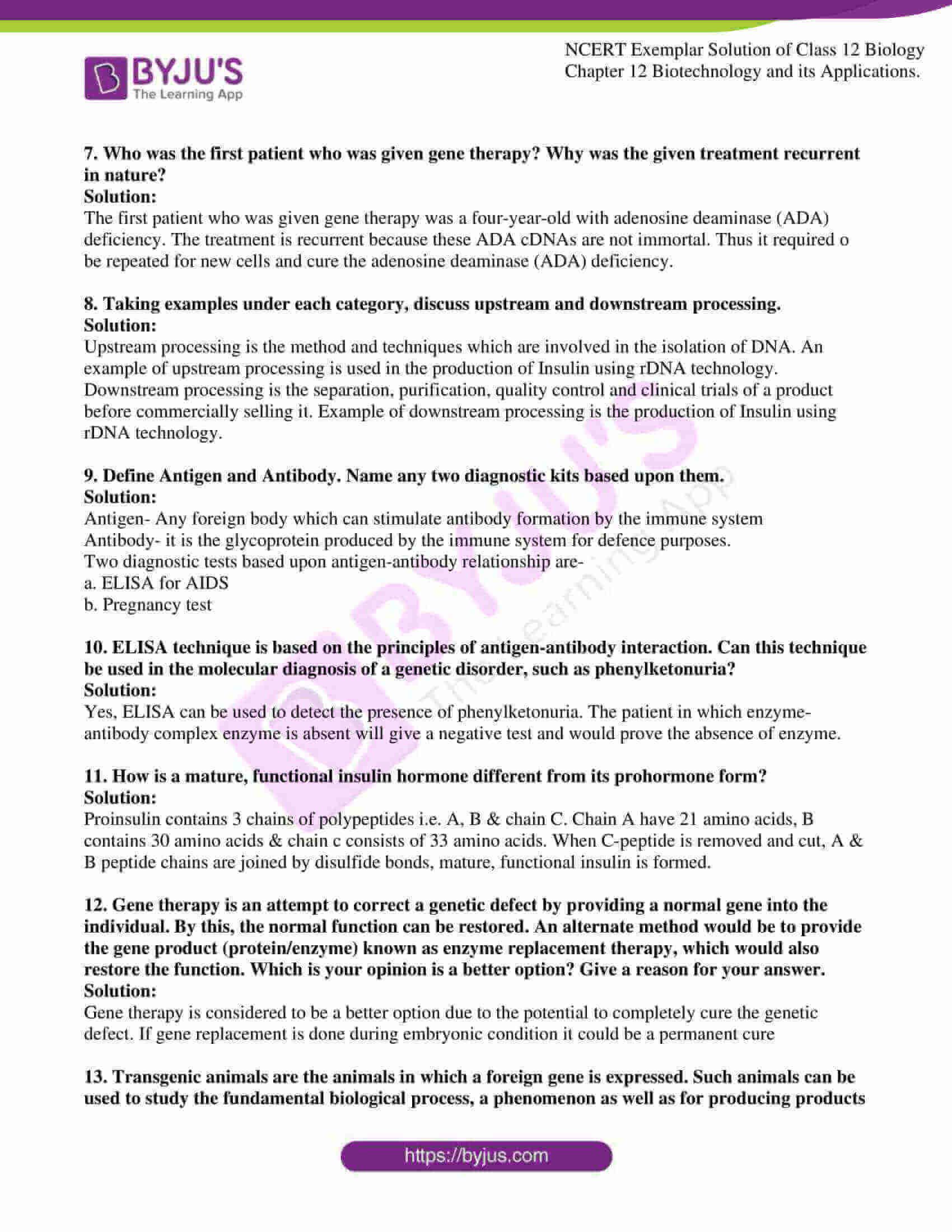
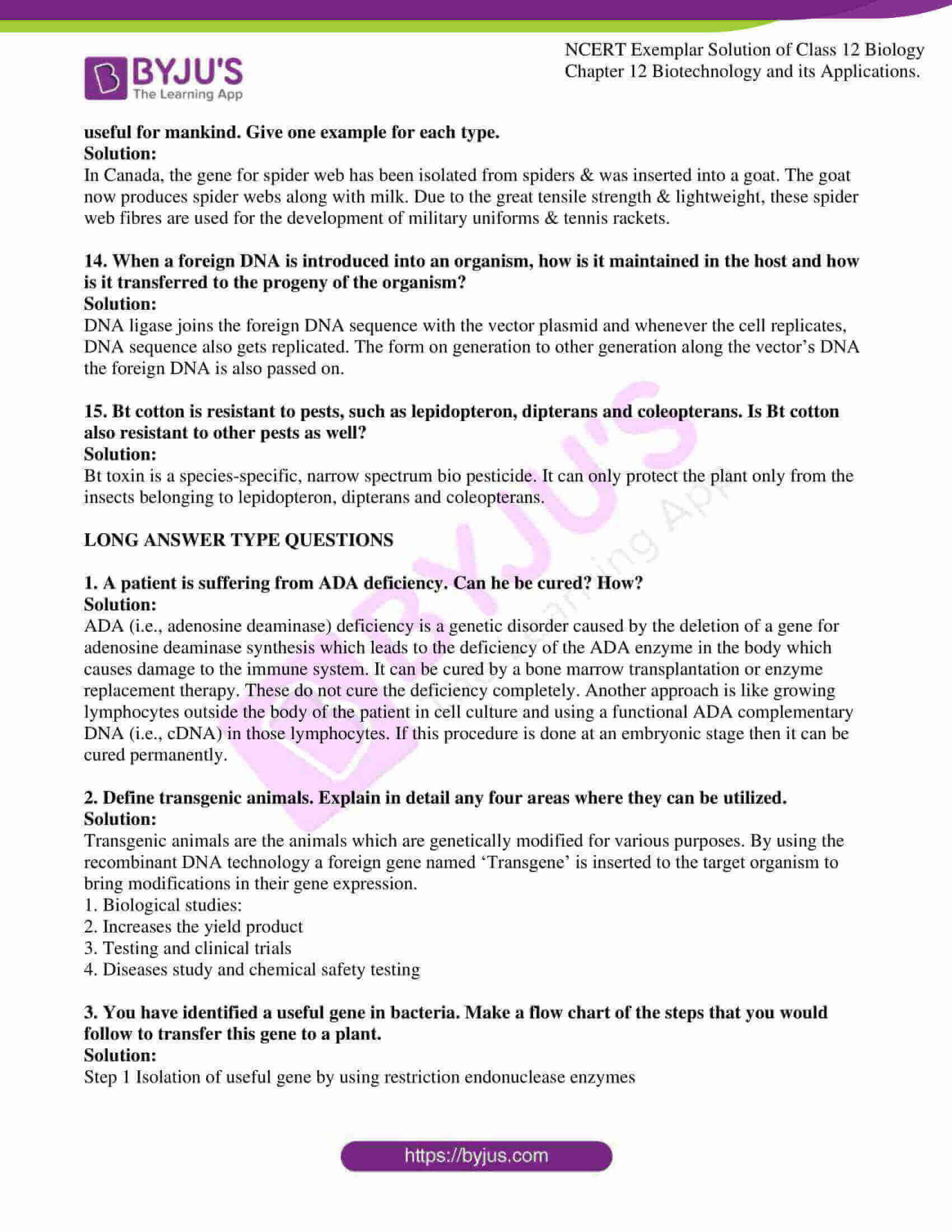

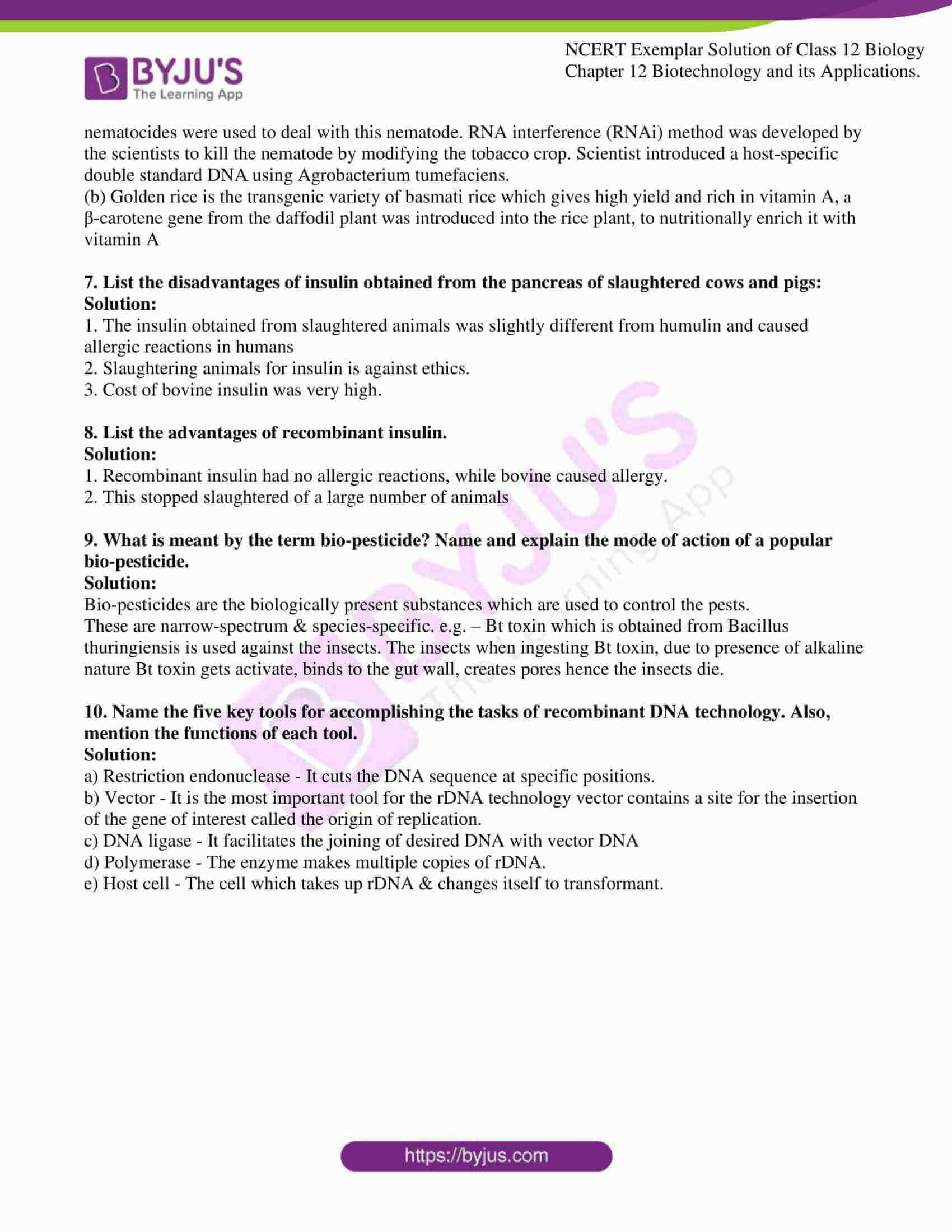

Comments